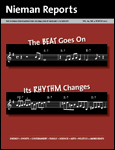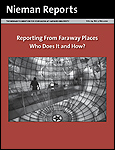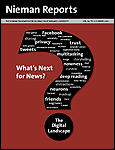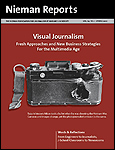Nieman Reports
With the publication of its quarterly magazine, Nieman Reports, the Nieman Foundation reaches a global audience in print and online with articles of substance and storytelling that is told with sensibility and insight through the personal voices of frontline journalists. On the magazine’s pages, reporters, editors, photographers and multimedia producers write out of their experiences; their words and images speak with authority about journalism’s core challenges and its array of emerging opportunities.
In 2010, together with new partners, including the Pulitzer Center on Crisis Reporting, Nieman Reports explored a wide range of diverse and timely topics for our global audience of readers:
 Winter 2010: The Beat Goes On — Its Rhythm Changes: What happens to beat reporting when resources shrink, new voices emerge and platforms multiply? With these core questions in mind, we turned to journalists for answers. Winter 2010: The Beat Goes On — Its Rhythm Changes: What happens to beat reporting when resources shrink, new voices emerge and platforms multiply? With these core questions in mind, we turned to journalists for answers.
They told us which topics stick around, which don’t, and the new beats that are emerging. We discovered the dizzying demands of covering a sports beat as Twitter cranks up the appetite for constant interaction and bloggers compete for attention. In “Words & Reflections,” Bill Kovach and Tom Rosenstiel let us know how journalists can reach news consumers in a time of information overload, and as e-book reading surges, authors who have turned to self-publishing provide insiders’ views of their experience. |
 Fall 2010: Reporting From Faraway Places: Who Does It and How?: From the start of her Pulitzer Center project, 2009 Nieman Fellow Fatima Tlisova designated Nieman Reports as the destination for the words she would write about her reporting trip back to the North Caucasus region of Russia. This was where she had been threatened for her reporting and from where she had fled into exile in 2007. Fall 2010: Reporting From Faraway Places: Who Does It and How?: From the start of her Pulitzer Center project, 2009 Nieman Fellow Fatima Tlisova designated Nieman Reports as the destination for the words she would write about her reporting trip back to the North Caucasus region of Russia. This was where she had been threatened for her reporting and from where she had fled into exile in 2007.
Her story “Brutal Censorship: Targeting Russian Journalists,” is among the more than 35 stories about foreign news reporting published in this issue, several of which highlight work supported by the Pulitzer Center. |
 Summer 2010: What’s Next for News? The Digital Landscape: In this issue, journalists and commentators, teachers and high school students, reading researchers and neuroscientists trekked through journalism’s digital landscape and mapped the various pathways that journalists use now — or might soon explore. In this endeavor, we partnered with several Knight Journalism Fellows at Stanford University, and their stories were published on their website as well as on our own. Summer 2010: What’s Next for News? The Digital Landscape: In this issue, journalists and commentators, teachers and high school students, reading researchers and neuroscientists trekked through journalism’s digital landscape and mapped the various pathways that journalists use now — or might soon explore. In this endeavor, we partnered with several Knight Journalism Fellows at Stanford University, and their stories were published on their website as well as on our own.
A unique Digital Library accompanied this issue online, providing links to news and information that supplements what appears in the magazine. |
 Spring 2010: Visual Journalism: Fresh Approaches and New Business Strategies for the Multimedia Age: By relying on the expertise of photographers, videographers and producers of multimedia presentations, Nieman Reports offered its readers a probing look at how digital news can be produced and distributed in visual media and how those doing this work can be adequately compensated as new business strategies take hold. Spring 2010: Visual Journalism: Fresh Approaches and New Business Strategies for the Multimedia Age: By relying on the expertise of photographers, videographers and producers of multimedia presentations, Nieman Reports offered its readers a probing look at how digital news can be produced and distributed in visual media and how those doing this work can be adequately compensated as new business strategies take hold.
In our Web edition, we partnered with our contributors to create slideshows and multimedia presentations to highlight examples of their work. |
Social Media Tools
-
Nieman Reports uses social media to share content from its pages and to draw attention to important conversations and stories about journalism found on the Web.
-
Nieman Reports is on Facebook at: www.facebook.com/NiemanReports
-
Nieman Reports sends out tweets at twitter.com/NiemanReports
With Nieman Reports archived at www.niemanreports.org in HTML format, stories that date back to our Spring 1998 issue can be read, commented on and distributed via social media. Earlier issues of the magazine are being converted to HTML over time.
Professor’s Corner
 Designed as one-stop shopping for j-school professors and students, Professor’s Corner is an online resource for up-to-date curriculum ideas, content and information. This website features articles from the current issue of Nieman Reports, offering possibilities for supplemental class reading and as a spur for lively class discussion. The articles we highlight are written either by reporters who were recently j-school students or by those who are teaching journalism.
Designed as one-stop shopping for j-school professors and students, Professor’s Corner is an online resource for up-to-date curriculum ideas, content and information. This website features articles from the current issue of Nieman Reports, offering possibilities for supplemental class reading and as a spur for lively class discussion. The articles we highlight are written either by reporters who were recently j-school students or by those who are teaching journalism.
The site also provides valuable classroom content through its Teaching Tools and Teaching Glimpses features:
Teaching Tools offers stories culled from the pages of Nieman Reports, which are united by topic for classroom use. The topics currently featured are:
Teaching Glimpses offer a place where professors describe approaches they are taking in engaging students in learning about journalism; in doing so, they share links to their students’ work.
Sue Burzynski Bullard, who teaches journalism at the University of Nebraska-Lincoln, wrote as the fall semester got underway about the essential role that blogs play in preparing students for the demands they will encounter when they graduate — and she highlighted how several j-school professors and their students are using them.
Moving Forward
Nieman Reports is working with Web manager Barbara McCarthy to redesign the home page for the web edition of the magazine. The goal is to highlight — on a rotating basis — a small number of stories from the issue in an inviting visual format, to provide links to related coverage from other publications and to display our magazine’s social media interactions. A link from that page will take the reader to what is now the current home page, where the table of contents will reside with links to each of the stories. We expect to launch a new home page for our Spring 2011 issue.
–Melissa Ludtke
Editor, Nieman Reports
Nieman Reports staff includes assistant editor Jan Gardner and editorial assistant Jonathan Seitz.